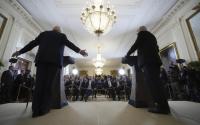21 September 2004Gregory Malandrucco
The signs are everywhere; according to this month's National Geographic magazine and a recent Pentagon report, global warming is very real. Worldwide, winters are noticeably more temperate; polar ice is diminishing, ocean warming is contributing to deadly hurricanes that are thrashing once seemingly disparate peoples with amazing impartiality; droughts are devastating potable water reserves promising to make it the next commodity of belligerence in the not too distant future.
It is evident on the local level as well. Record heat waves killed an estimated 10,000 people in France during the summer of 2003. Greenland and Alaska are melting and parts of the latter were subsequently ablaze (as were many parts of the Northwest) in recent months.
Meanwhile in Southern California, the smog is thicker and more imposing and the possibility of another burning season disquieting - with the ferocity of last year's serving as an acute reminder.
For more than a week in late October 2003, the wildfires of Southern California became one of the leading news stories in the American media, much like the hurricanes of recent weeks. The conflagrations began in the foothills of San Bernardino County, just east of Los Angeles. Severe drought compounded by strong winds spread the flames quickly throughout parts of Southern California, burning hundreds of thousands of acres of brush and forest and killing 24 people. For several days, the fires produced gray smoke that blocked the typical sunlight in the heavily populated suburban areas east of Los Angeles and eventually brought thick ash and darkness to sunny Las Vegas, 300 kilometers to the east. It was quite literally a taste of doomsday for millions of people as ashes rained perpetually from the eerie, darkened sky.
So who was to blame for this horror? Apparently, the media had its fall guy. American media decidedly focused on one "evil-doer" witnessed near the "point of origin" of a secondary fire. The arsonist's ambiguous composite sketch, replete with a large reward for his apprehension, was posted in every imaginable public and private space, (even at the billing desk of a local public hospital).
The sensational around the clock coverage of these enormous fires, (with the composite sketch of the suspect at times superimposed over the live footage), were reminiscent of the media's coverage of violent crimes and terrorist acts. The corporate media persistently reminded the public of the terror caused by fire, subsequently ignoring the social and environmental factors that played a role in the destruction of local and global ecosystems that created the conditions so ripe for conflagration.
The corporate media concluded that the cause of the fire was arson and was fueled by an unprecedented drought, an October heat wave and an unincited bark beetle infestation of the local forests. The term "global warming" was absent from the mainstream media's catalog of contributing factors. The fact that the fires burned in hills and mountains that block inordinate levels of smog from the Los Angeles area, and therefore, are submerged by toxic levels of ozone and particle pollution throughout the year was certainly never mentioned.
The mystery arsonist was a convenient fall guy. A man who just lost his house to flames said to a reporter, "if I could get my hands on the person who lit these fires, I can't even say what I would do." The corporate media loves such a quote just as it loves such a fall guy. The unstated threat articulated a key tenet of America's go-it-alone character that is in so many ways bound to the "freedom" and "agency" of the "purchase" in our consumer culture. It is therefore one of the sustaining canons of the corporations that control information.
If global warming is so evident to scientists, the world's people, and even the Pentagon, then why does the media barely mention global warming? The corporate media's "un-scientific" approach to environmental disasters is tantamount to a denial of American complicity. Whether it is crime, terrorism, or vast natural catastrophes such as wildfires or hurricanes, it seems that blame, denial, and silence are the mechanisms that enable the collective to ignore the ramifications of its actions, thus facilitating its destructive ways. In a society that prides itself on individualism, maybe it is more cunning or just easier to blame one individual for intentionally lighting the fires - the "fall guy" for the detrimental actions of the collective - in order for the masses to continue consuming products carelessly to the corporate media's immediate financial benefit.
No arsonist was ever apprehended based on the composite sketch. With most of the corporate media and their fall guy still at large, perhaps there is further reason to be alarmed by the possibility of another fire season in Southern California, and wherever else they may strike.
Gregory Malandrucco is a graduate student of History at the University of Chicago. He can be reached at [email protected]






